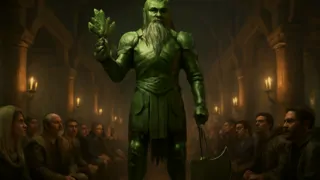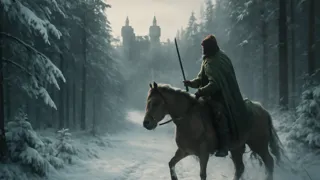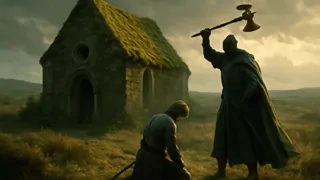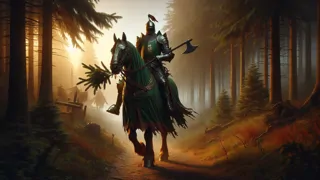Introduction
Snow lay thick upon Camelot’s ramparts, blanketing the turrets and winding stone pathways in a hush of pure white. Torches glowed like living embers along the battlements, their golden glow dancing upon the polished armor of knights and lords gathered in the great hall. Warm laughter and the clatter of goblets echoed beneath a canopy of evergreen boughs hung with crimson berries, while a chorus of minstrels strummed lutes near the high dais. King Arthur, his shining helm crowned with a circlet of holly, presided over the feast with radiant grace. Yet, amid the flicker of candlelight and the scent of spiced wine, a silent tension thrummed through the assembly. In the distance beyond the frost-kissed windows, a lone horn sounded—deep, rolling, and insistent in the silent wood. Without warning, the massive doors swung wide, revealing a figure unlike any Camelot had seen. Clad head to foot in emerald armor, the stranger’s skin and beard gleamed green as he bore a sprig of holly in one hand and a colossal axe in the other. A hush fell over the knights; breath caught in their throats as the enigmatic visitor strode forward to speak a challenge that would test their very vows. Brave Sir Gawain, ever mindful of honor, rose from his seat with steady eyes. He stepped into the torchlight, cloak brushing marble, and offered his life on the sacred promise of chivalry. Thus began a quest that would carry him beyond the safety of Camelot’s walls into forests veiled in mist and over hills blanketed in snow—a quest not only for survival but for the enduring strength of his honor and heart.
The Mysterious Visitor at Camelot
Camelot’s great hall was alive with pageantry. Garlands of fresh holly draped the rafters, and tables groaned under platters of spiced meats, sweet cakes, and goblets brimming with ruby wine. Knights of the Round Table, resplendent in polished hauberk and brightly colored surcoat, traded jests and tales of distant campaigns beneath banners embroidered with dragon, griffin, and crowned A. Young pages darted between the benches, bearing platters of roast pheasant and spiced mead. At the head of the hall, King Arthur sat upon an elevated dais carved from oak, his golden gaze sweeping over the assembly with warmth and regal authority. Beside him, Queen Guinevere looked on with quiet pride, her dark hair woven with thread of silver and mistletoe berries.

Just as the revelry reached its height, a horn sounded sharp against the laughter. All eyes turned as the massive doors of the hall creaked open. There, silhouetted against the frosty moonlight spilling through the open doorway, stood a knight unlike any they had known. His armor, head to toe, shone in a vivid hue of living green. Even his hair, beard, and the skin beneath seemed woven from emerald itself. He carried a holly sprig in one gauntleted hand and, in the other, an axe of such weight and craftsmanship it looked destined to cleave boulders rather than flesh. Silence seized the hall as the stranger strode forward, each booted step echoing on polished stone.
With a voice that rolled like distant thunder, the Green Knight challenged the knights of Arthur’s court to a game of honor. Any one of them might step forward to strike the giant with his own axe—once, and only once—so that one year hence the challenger might return the blow in kind. Whispers raced around the hall as the knights exchanged uneasy glances. None dared test his mettle against such fearsome power. At that moment, Sir Gawain rose. Heart pounding, cloak trailing behind, he approached with measured steps. He laid his sword upon the polished block at the foot of the stranger and, under the watchful eyes of king and court, drew the green axe and delivered a single clean stroke.
The axe rang on stone, and the stranger’s head flew free but landed upright in his mailed hand. In return, with a voice that trembled half in mirth and half in challenge, he reminded Gawain of the appointed time and place: one year hence, at the Green Chapel, the knight must uphold his promise. With that, he mounted his steed and vanished into the swirling mists of the forest, leaving Camelot’s bravest to grapple with his fate.
Sir Gawain’s Oath and the Year of Vigil
The chill wind of autumn gave way to icy breaths of winter as Sir Gawain set forth from Camelot, heavy with the weight of his promise. Clutching the holly sprig gifted by the Green Knight, he rode through forests stripped bare of leaves, their skeleton branches scraping the sky like silent sentinels. Frost clung to every stone and boulder, and snowdrifts muffled the steady thunder of his steed’s hooves. Each day brought him closer to the appointed hour, and every night he knelt beneath infinite stars, praying for guidance and strength.

Along the winding path, Gawain encountered crossroads of temptation. In a hunting lodge set against a frozen lake, a gracious lord offered him warmth by a glowing hearth and a cloak of finest green silk as protection against the biting cold. The lord’s lady, radiant beneath soft candlelight, praised Gawain’s courtesy and pressed upon him a silken girdle of emerald thread, claiming it would ensure his safety should the time of reckoning arrive. Gawain thanked her with a curtsy, his heart caught between desire for self-preservation and loyalty to his vow.
As the year waned, Gawain’s mind wrestled with the conflicting urges of prudence and honor. He remembered the proud voices of Camelot extolling truth and transparency. He recalled the Green Knight’s challenge laid bare: to meet him without fear a single stroke returned for a stroke given. With dawn light cresting distant hills, he set the silken gift aside, choosing instead to face the unknown with only his shield and sword by his side.
The journey, fraught with biting cold and haunting shadows, forged his spirit as iron is tempered by flame. Each step carried him through valleys where wolves prowled beneath skeletal trees and across ridges bathed in moonlight. In that relentless march he learned that honor demands not simply grand gestures but quiet, unyielding resolve in the face of inner doubt.
The Trial at the Green Chapel
At last, on a bleak winter morning, the Green Chapel emerged on the horizon—an ancient ruin half-swallowed by brambles and moss. Its crumbling stones seemed to breathe with a life of their own, wrapped in swirling fog that clung to every crevice. Gawain dismounted and approached on foot, axe in hand, heart pounding beneath his polished breastplate. The door, once carved with runic script, hung on warped hinges, groaning its own warning.

Within, the Green Knight greeted him as a humble host wearing a cloak the color of peat. Candles flickered in the alcoves but cast only a dim, wavering light. Gawain knelt before the raised stone slab where he had first struck the challenge. The stranger produced his own axe—still gleaming—its edge cold and unyielding. A hush fell. Friends in Camelot had cheered for justice; here, only the echo of wind through broken walls remained.
With reverent calm, Gawain offered his neck and recalled every step of his oath. The Green Knight raised the axe high. With one swift, practiced motion, the blade descended. Gawain braced, expecting the cruel crack of bone. Instead there was a gentle tap. The knight smiled with a knowing glint. In that moment, Gawain saw through the emerald face of his challenger: the kindly lord he had befriended, come to test his truth.
Words flowed soft as dawn’s first glow. The lord praised Gawain’s steadfastness, chastising only a single falter when the knight had accepted the silken girdle in fear of death. Though the blade had spared his life, Gawain’s eyes shone with remorse. The lord laid bare the lesson: true honor demands honesty above all. Emboldened and forgiven, Gawain rose with renewed spirit, bound forever by the fellowship of vulnerability and valor.
Conclusion
Returning to Camelot beneath a sky bright with winter sun, Sir Gawain carried more than the scar left by the Green Knight’s gentle blow. He bore within him the true measure of chivalry: a trust forged not by perfection but by the courage to stand honest before one’s own failings. The knights gathered to greet him with cheers and embraces, yet he found his greatest triumph in the quiet reflection of what had passed. The holly sprig he still carried was no mere decoration, but a living emblem of mercy and truth. Wiser in spirit and humbler of heart, Gawain returned to Arthur’s court as both a knight and a man reborn by his own vow. His tale became a beacon of integrity, shining bright long after the frost had melted from Camelot’s ramparts.



















